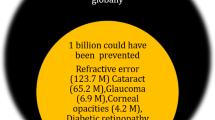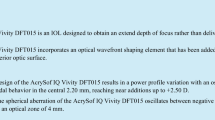Abstract
This research is aimed at accurate identification of base-curve in rigid gas-permeable (RGP) lens based on supervised image processing and classification of Pentacam four refractive maps in irregular astigmatism cases. Base-curve, is typically identified based on expert’s opinion of the corneal structure of the eye. Studies have applied time-consuming methods, focusing on manual and device-based techniques. For the identification of the base-curve of a lens, image analysis is proposed. As each map in the four refractive maps is of a singular view, multi-view learning is recommended to provide a single representation. To this end, an authentic dataset consisting of 247 labeled Pentacam four refractive maps was gathered in which labels were verified manually. We have proposed two novel feature extraction techniques in this domain: quantization-based radial–sectoral segmentation (QRSS) in image processing and deep convolutional neural networks. Feature fusion is applied and RGP base-curve is identified by the regression layer of a neural network. A combination of QRSS and multilayered perceptron delineates the best result, achieving a coefficient of determination of 0.9642 and satisfactory mean square error (0.0089) which is acceptable by the experts. The proposed multi-view model could improve base-curve detection accuracy, with less trial and error and patient visits in the lens fitting process.





Similar content being viewed by others
References
Mathews, S.M., Bradley, J.C., George, J.G., Xu, K.: Predicting contact lens base curve using corneal topography in keratoconus. Invest. Ophthalmol. Vis. Sci. 46, 18 (2005)
Siddireddy, J.S., Mahadevan, R.: Comparison of conventional method of contact lens fitting and software based contact lens fitting with Medmont corneal topographer in eyes with corneal scar. Contact Lens Anterior Eye 36(4), 176–181 (2013)
Anwar, S.M., Majid, M., Qayyum, A., Awais, M., Alnowami, M., Khan, M.K.: Medical image analysis using convolutional neural networks: a review. J. Med. Syst. 42(11), 226 (2018)
Zu, C., Zhu, L., Zahng, D.: Iterative sparsity score for feature selection and its entension for multimodal data. Neurocomputing 259, 146–153 (2017)
Nosch, D.S., Ong, G.L., Mavrikakis, I., Morris, J.: The application of a computerised videokeratography (CVK) based contact lens fitting software programme on irregularly shaped corneal surfaces. Cont Lens Anterior Eye 30(4), 239–248 (2007)
Ortiz-Toquero, S., Rodriguez, G., de Juan, V., Martin, R.: Rigid gas permeable contact lens fitting using new software in keratoconic eyes. Optom. Vis. Sci. 93(3), 286–292 (2016)
Ortiz-Toquero, S., Rodriguez, G., de Juan, V., Martin, R.: New web-based algorithm to improve rigid gas permeable contact lens fitting in keratoconus. Contact Lens Anterior Eye 40(3), 143–150 (2017)
Alió, J.L., Belda, J.I., Artola, A., García-Lledó, M., Osman, A.: Contact lens fitting to correct irregular astigmatism after corneal refractive surgery. J. Cataract Refract. Surg. 28(10), 1750–1757 (2002)
Cardona, G., Isern, R.: Topography-based RGP lens fitting in normal corneas: the relevance of eyelid and tear film attributes. Eye Contact Lens Sci. Clin. Pract. 37(6), 359–364 (2011)
Mandathara, P.S., Fatima, M., Taureen, S., Dumpati, S., Ali, M.H., Rathi, V.: RGP contact lens fitting in keratoconus using FITSCAN technology. Contact Lens Anterior Eye 36(3), 126–129 (2013)
Alkhaldi, W.: Statistical Signal and Image Processing Techniques in Corneal Modeling, TU Darmstadt (2010)
Alkhaldi, W., Iskander, D.R., Zoubir, A.M., Collins, M.J.: Enhancing the standard operating range of a Placido disk videokeratoscope for corneal surface estimation. IEEE Trans. Biomed. Eng. 56(3), 800–809 (2009)
Hasan, S.A., Singh, M.: Automatic diagnosis of astigmatism for Pentacam sagittal maps. In: International Conference on Advances in Computing, Communications and Informatics (ICACCI), pp. 472–478 (2014)
Hasan, S.A.: Novel algorithm to differentiate astigmatism from keratoconus. Doctoral dissertation, Thapar University (2014)
Grewal, D., Jain, R., Brar, G.S., Grewal, S.P.S.: Pentacam tomograms: a novel method for quantification of posterior capsule opacification. Invest. Ophthalmol. Vis. Sci. 49(5), 2004–2008 (2008)
Gillner, M., Eppig, T., Langenbucher, A.: Automatic intraocular lens segmentation and detection in optical coherence tomography images. Z. Med. Phys. 24(2), 104–111 (2014)
Murawski, K., Biaas, D., Rekas, M.: Measurement of corneal neovascularisation with the use of image processing techniques. Acta Phys. Pol. A 127(6), 1732–1736 (2015)
Twa, M.D., Parthasarathy, S., Raasch, T.W., Bullimore, M.: Decision tree classification of spatial data patterns from videokeratography using zernike polynomials. In: Proceedings of the 2003 SIAM International Conference on Data Mining, pp. 3–12 (2003)
Twa, M.D., Parthasarathy, S., Roberts, C., Mahmoud, A.M., Raasch, T.W., Bullimore, M.A.: Automated decision tree classification of corneal shape. Optom. Vis. Sci. Off. Publ. Am. Acad. Optom. 82(12), 1038 (2005)
Hidalgo, I.R., et al.: Automated detection of Fuchs’ dystrophy through a machine learning algorithm using Pentacam data. Invest. Ophthalmol. Vis. Sci. 56(7), 1641 (2015)
Toutounchian, F., Shanbehzadeh, J., Khanlari, M.: Detection of keratoconus and suspect keratoconus by machine vision. In: Proceedings of the International Multi Conference of Engineers and Computer Scientists, vol. 1 (2012)
Liu, W., Wang, Z., Liu, X., Zeng, N., Liu, Y., Alsaadi, F.E.: A survey of deep neural network architectures and their applications. Neurocomputing 234, 11–26 (2017)
He, K., Wang, Y., Hopcroft, J.: A powerful generative model using random weights for the deep image representation. In: Advances in Neural Information Processing Systems (2016)
Havaei, M., et al.: Brain tumor segmentation with deep neural networks. Med. Image Anal. 35, 18–31 (2016)
Shin, H.C., Lu, L., Kim, L., Seff, A., Yao, J., Summers, R.M.: Interleaved text/image deep mining on a very large-scale radiology database. In: Proceedings of the IEEE Conference on Computer Vision and Pattern Recognition, pp. 1090–1099 (2015)
Jie, B., Zhang, D., Cheng, B., Shen, D.: Manifold regularized multitask feature learning for multimodality disease classification. Hum. Brain Map 36(2), 489–507 (2015)
Shin, H.C., et al.: Deep convolutional neural networks for computer-aided detection: CNN architectures, dataset characteristics and transfer learning. IEEE Trans. Med. Imaging 35(5), 1285–1298 (2016)
Krizhevsky, A., Sutskever, I., Hinton, G.E.: ImageNet classification with deep convolutional neural networks. In: Advances in Neural Information Processing Systems (NIPS), vol. 25, pp. 1097–1105 (2012)
Ioffe, S., Szegedy, C.: Batch normalization: accelerating deep network training by reducing internal covariate shift. In: 32nd International Conference on Machine Learning (2015)
Zou, J., Rui, T., Zhou, Y., Yang, C., Zhang, S.: Convolutional neural network simplification via feature map pruning. Comput. Electr. Eng. 70, 950–958 (2018)
Mohammed, E.: A framework intelligent mobile for diagnosis contact lenses by applying case based reasoning. In: Innovations and Advances in Computer, Information, Systems Sciences, and Engineering, Springer, pp. 1233–1238 (2013)
Wang, K., Zhou, S., Fu, C.A., Yu, J.X.: Mining changes of classification by correspondence tracing. In: Proceedings of the 2003 SIAM International Conference on Data Mining, pp. 95–106 (2003)
Xu, C., Tao, D., Xu, C.: A survey on multi-view learning. Neural Comput. Appl. 23(7–8), 2031–2038 (2013)
Poria, S., Cambria, E., Bajpai, R., Hussain, A.: A review of affective computing: from unimodal analysis to multimodal fusion. Inf. Fusion 37, 98–125 (2017)
Poria, S., Cambria, E., Howard, N., Huang, G.-B., Hussain, A.: Fusing audio, visual and textual clues for sentiment analysis from multimodal content. Neurocomputing 174, 50–59 (2016)
Poria, S., Cambria, E., Hussain, A., Huang, G.-B.: Towards an intelligent framework for multimodal affective data analysis. Neural Netw. 63, 104–116 (2015)
Turk, M.: Multimodal interaction: a review. Pattern Recognit. Lett. 36, 189–195 (2014)
Belin, M.W., Khachikian, S.S.: Keratoconus/ectasia detection with the oculus pentacam: Belin/Ambrósio enhanced ectasia display. Highlights Ophthalmol. 35(6), 5–12 (2007)
Hashemi, H., Mehravaran, S.: Day to day clinically relevant corneal elevation, thickness, and curvature parameters using the orbscan II scanning slit topographer and the pentacam scheimpflug imaging device. Middle East Afr. J. Ophthalmol. 17(1), 44 (2010)
Chen,Y., Wu, M.: A level set method for brain MR image segmentation under asymmetric distributions. In: Signal, Image Video Process, pp. 1–9 (2019)
Naqvi, S.S., Fatima, N., Khan, T.M., Rehman, Z.U., Khan, M.A.: Automatic optic disk detection and segmentation by variational active contour estimation in retinal fundus images. In: Signal Image Video Process, pp. 1–8 (2019)
Huidrom, R., Chanu, Y.J., Singh, K.M.: Pulmonary nodule detection on computed tomography using neuro-evolutionary scheme. Signal Image Video Process 13(1), 53–60 (2019)
Yang, T., Chen, Y., Lu, J., Fan, Z.: Sampling with level set for pigmented skin lesion segmentation. Signal Image Video Process 13(4), 813–821 (2019)
Guo, Y., Liu, Y., Oerlemans, A., Lao, S., Wu, S., Lew, M.S.: Deep learning for visual understanding: a review. Neurocomputing 187, 27–48 (2016)
Kim, P. Convolutional neural network. In: MATLAB Deep Learning, Apress, Berkeley, CA, pp. 121–147 (2017)
Kim, P.: MATLAB Deep Learning: With Machine Learning, Neural Networks and Artificial Intelligence. Apress, Berkeley (2017)
Galvis, V., Tello, A., Ortiz, A.I.: Corneal collagen crosslinking with riboflavin and ultraviolet for keratoconus: long-term follow-up. J. Cataract Refract. Surg. 41(6), 1336–1337 (2015)
Bausch and Lomb.: Boston gas permeable contact lens materials (2016). http://www.bauschsvp.com/Portals/137/assets/boston-xo-eo-es-insert.pdf
Ortiz-Toquero, S., Rodriguez, G., de Juan, V., Martin, R.: Gas permeable contact lens fitting in keratoconus: comparison of different guidelines to back optic zone radius calculations. Indian J. Ophthalmol. 67(9), 1410–1416 (2019)
Author information
Authors and Affiliations
Corresponding author
Ethics declarations
Conflict of interest
The authors declare that they have no conflict of interest.
Ethical approval
All procedures performed in studies involving human participants were in accordance with the ethical standards of the institutional and/or national research committee and with the 1964 Helsinki Declaration and its later amendments or comparable ethical standards.
Informed consent
Informed consent was obtained from all individual participants included in the study.
Additional information
Publisher's Note
Springer Nature remains neutral with regard to jurisdictional claims in published maps and institutional affiliations.
Rights and permissions
About this article
Cite this article
Hashemi, S., Veisi, H., Jafarzadehpur, E. et al. An image processing approach for rigid gas-permeable lens base-curve identification. SIViP 14, 971–979 (2020). https://doi.org/10.1007/s11760-019-01629-8
Received:
Revised:
Accepted:
Published:
Issue Date:
DOI: https://doi.org/10.1007/s11760-019-01629-8




